From my perspective, this is the last CKHH blog. Consequently, I would just like to say that when Matthew Crockatt said back in 2014 the best way to build an audience was to post regularly and often, I still find it amazing that it has reached over 530 blogs since its inception.
However, it has been good to be able to provide you with news about forthcoming history and heritage events, to report on such events, including various conferences, workshops, study days, lectures and most particularly our decade of History Weekends, as well as to offer short (well moderately short) pieces on research features, especially where I have been able to draw on archival documents to explore the lives of men and women in Kent’s medieval and early most past. Although sometimes more modern items have occasionally crept in, in addition to some medieval animals!
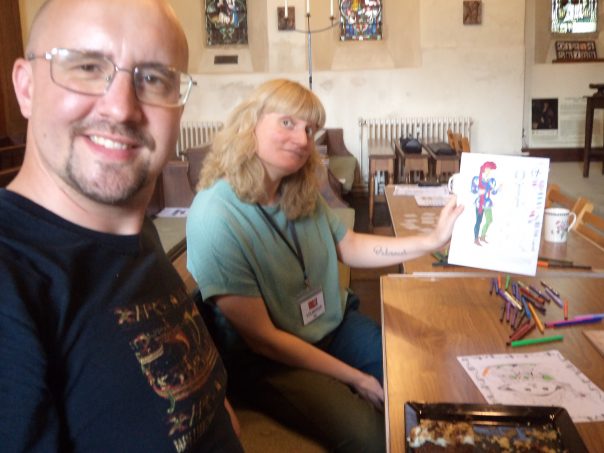
For this final one under CCCU, I’ll be highlighting the activities this week and next of several of the members of the Kent History Postgraduates group before providing a round-up on the Gender and Medieval Studies conference, the last CKHH event for the 2024/25 academic year. So to begin, congratulations are due to Grace Conium who had her PhD viva this week, which she has passed with minor corrections, and to Maureen Mcleod and Lisa Duffy who have both submitted their doctoral theses. These are very important milestones on the PhD journey. Giving conference papers is another rite of passage and on Friday Kieron Hoyle spoke at the international Society of Renaissance Studies conference at the University of Bristol, while Dr Claire Bartram similarly gave a paper there. Lizzie Burton and Abi Kingsnorth will be speaking next week at another prestigious conference, the Social History Society’s conference at the Black Country Living Museum in Dudley, where they will be joined by Dr David Hitchcock who will also be presenting.
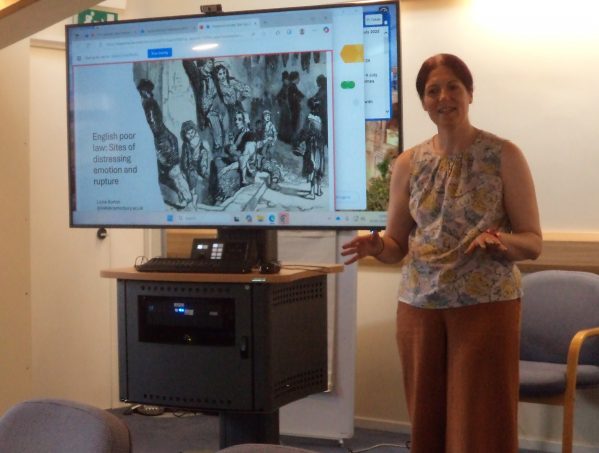
This brings me to Lizzie’s presentation to the Kent History Postgraduates group on Wednesday where she wanted to test out some of her ideas ahead of the conference. As some may remember from previous talks given by Lizzie to the group and reported here, she is working on sites of distressing emotion and rupture experienced by poor people in the early modern period. Having set up the contextual and theoretical framework in which she is locating her research, the case study she will be discussing at Dudley is the great fire of Northampton in 1675 when a large part of the town was burnt. Lizzie has been able to bring together a mix of documents, including several pamphlets. From these she is exploring the ‘life’ of a poor old woman who was blamed for being the cause of this disaster, starting with the details highlighted in a specific pamphlet and then drawing on surrounding evidence to consider her likely back story. This deployment of what can be seen as specifics alongside more generalities concerning the lives of the poor is allowing Lizzie to interrogate a range of sites of emotion and trauma, and thus the lived experience of poverty. Her presentation fired a series of questions and comments by those in the room and online, and hopefully she will get further useful feedback when she gives her paper at the conference.
In some ways there are some interesting crossovers between the ways Lizzie is presenting her research findings and one of the sessions at the Gender and Medieval Studies conference that took place at CCCU this week. The theme for the GMS conference this year is Gender: Charity and Care and because I want to try to include all the speakers, I’m going to work through giving a very short summary of the sessions.
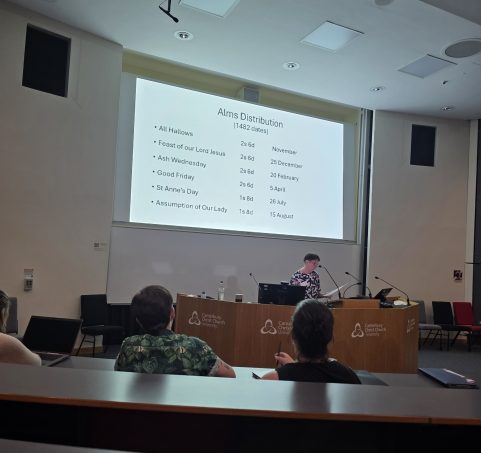
As the primary host for the conference, Dr Diane Heath welcomed the over 50 delegates at lunch time on Wednesday and, after lunch, she provided a gentle introduction to the conference by guiding them on a campus eco-tour to highlight the way green heritage and sustainability are part of the university’s ethos, including her own ‘green dragons’. Returning to Old Sessions House, the first session was my plenary lecture on what we know from archival sources about hospital sisters in (east) Kent in the Middle Ages. Due to the nature of the sources, I was primarily drawing on medieval hospital records for the Cinque Ports, especially Sandwich, as well as those for Canterbury. We looked at the selection criteria used by various hospital authorities, followed by what we can ascertain about life as a hospital sister before finishing with wills and what they can tell us about the community of the living and the dead, inside and outside the hospital.
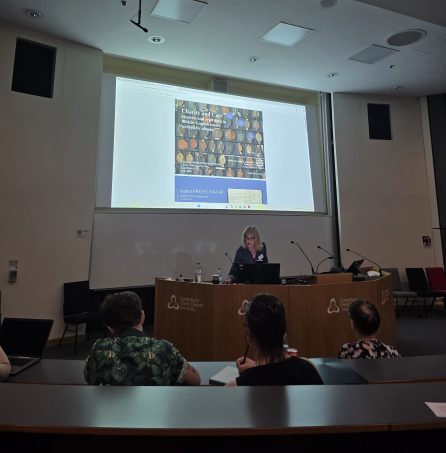
The second session (Panel 1) on ‘Charity in Action’ featured 3 presentations. Professor Virginia Davis explored the will of Alice Neville, a Yorkshire gentry widow, who intended that post mortem her son would oversee the establishing of a small almshouse for 2 poor women, who in return would pray for her soul. Through this case study, she examined how we as historians should understand such charitable giving and the extent to which such late medieval testamentary bequests were gendered. Looking at the other side of the coin, Professor Kenna Olsen’s case study deployed 3 late Middle English letters by women who sought in different way to manoeuvre the memory of their relationship with the recipient of the letter in their quest for help and charity. Thirdly, MaryEllen Linnehan, a postgraduate student at Cambridge, investigated medieval understandings and deployment of the woman mourner as a grief representative of the community through an exploration of representations of female grief in a range of sources – from Marian laments in medieval cycle plays, ideas articulated in Christine de Pizan’s work to the frequently seen as excessive expressions of grief shown by Margery Kempe, thereby highlighting the importance of women in this public and cultural act of caring.
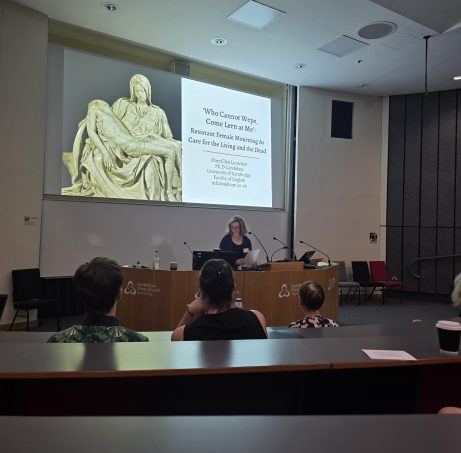
This brought the more formal aspects of the conference to an end on day one, but some delegates thereafter took the opportunity to attend Evensong at the cathedral and to explore the cathedral and precincts, for by that point in the day it had cooled down slightly. Although not a lot and Thursday brought a second scorching day, the conference having moved to Powell.
The first of the morning sessions brought a choice: ‘Care and Creativity in the Medieval Now’ and ‘Compassion in Context’. ‘Care and Creativity’ (Panel 2) involved 4 speakers. Caroline Banerjee, a PhD student at the University of London, discussed Caroline Bergvall’s work Alisoun Sings (2019) where the poet uses the idea of a conversation between herself and Alisoun, Chaucer’s ‘Wife of Bath’ to consider ideas about collaborative authorship through an emerging community of strong female voices. The second presentation by Dr Vicki Blud looked at acknowledgements that we as medievalists – researchers, collaborators, authors – often write, and she juxtaposed this in relation to Margery Kempe’s acknowledgements, not of a patron but rather of those from the various communities that supported her, setting this need for community in a world that currently has been described as being ‘on fire’. The third presentation by Heather Glover, a PhD student at the University of Lincoln, interrogated Grace Warrock’s Arts and Crafts style edition of Julian of Norwich’s Revelations of Divine Love. Her special focus was Julian’s imagery of motherhood and childhood and how Warrock’s edition reflects this through image and text. Dr Laura Varnam provided a different approach to an exploration of motherhood and childhood – then and now – by firstly looking at critical responses to the ‘absent presence’ of Margery Kempe’s children in her book before finishing with a reading of her new poem ‘Margery Kempe on the number 33 bus to Norwich with her fourteen children’.
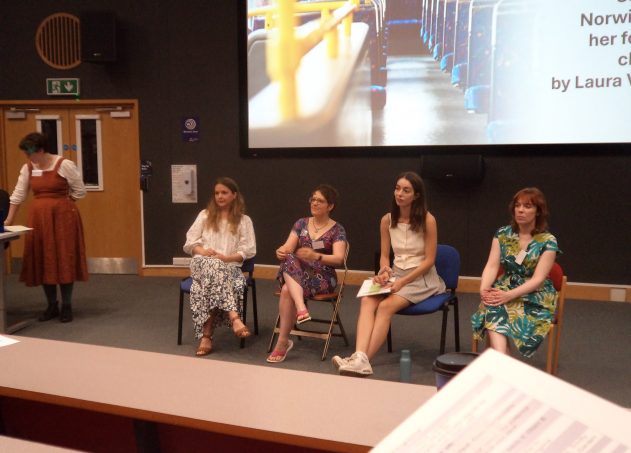
For those who opted instead for ‘Compassion in Context’ (Panel 3), their first speaker was Eve Johnson, a PhD student at Swansea University. Eve used several case studies deploying texts from medieval England and Wales to illustrate similarities in terms of depictions of grief and compassion. The idea of depictions in selected texts was taken up next by Moss Pepe, a doctoral student at the University of Edinburgh, who examined the gendering of infants in Old French literature, thereby nuancing such ideas in the light of recent theoretical scholarship. Oliver Wilkin, another PhD student from Wales, similarly considered several medieval texts in the light of the gender markers provided by authors such as Chaucer in an attempt to create a ‘more inclusive academic and cultural climate’. As you would expect, these panels stimulated a range of questions and comments, not least because each had considerable crossovers regarding themes and responses.
The next session brought a choice of either ‘Envisioned Caring and Gendering’ (Panel 4) or ‘Giving’ (Panel 5). For Panel 4, the first speaker was David Carillo-Rangel who spoke on differing readings of the Revelationes of Birgetta of Sweden, with special reference to the scholarship of C. Riley Snorton. Dr Hannah Johnson spoke next, arguing for a ‘lesbian’ interpretation of the union with the divine in the figure of caritas in Gertrud’s Legatus divinae pietatis, and therefore what this tells us about Gertrud’s theological and spiritual experiences of divine love. The final speaker was Dr Amanda Langley who discussed matters relating to almsgiving and charity as a virtue as seen in the text Visiones cuiusdam virginis.
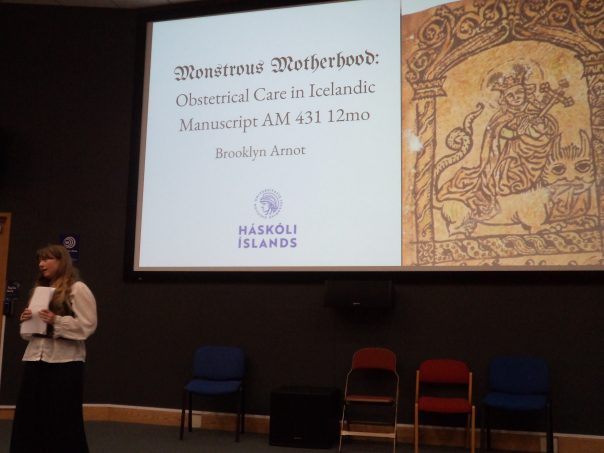
For the panel on ‘Giving’ (Panel 5), the first presentation was by Dr Gulrukh Khan who explored charity as a gendered and political act within the Mughal empire that was enacted by women and eunuchs as well as kings, thereby blurring the boundaries of gendered power. She was followed by Rachael Haslam, a PhD student at the University of York, who used cases from the church courts to investigate the social life of bequests before and after the testator’s death. Dr Kit Kappahn gave the final presentation where she discussed the genderfluid and liminal position of the medieval Welsh bard in the culture of gift giving that centred on the triangulation of lord, lady and poet.
After these fascinating sessions that equally generated numerous questions and comments from their respective audiences, the conference broke for lunch before reconvening for the first of the afternoon sessions that began with a choice between ‘Caring Beasts’ and ‘Carelessness?’. Brooklyn Arnot, a PhD student at the University of Iceland, spoke first in ‘Caring Beasts’ where she explored the meanings and use of the marginal images of monsters and mythical beasts in a Icelandic manuscript of the saga of Saint Margaret which could have offered spiritual care to its owner. Keeping with the notion of care through the deployment of medieval animals, Dr Diane Heath highlighted how the dragon, the whale and the nightingale have been employed to undertake matters of environmental sustainability, wellbeing and outreach in a contemporary context. The final paper by Dr Gillian Redfern offered a fascinating investigation of the medieval hare through a range of images, and she concluded with a reading and brief discussion of the later medieval poem ‘The Names of the Hare’.
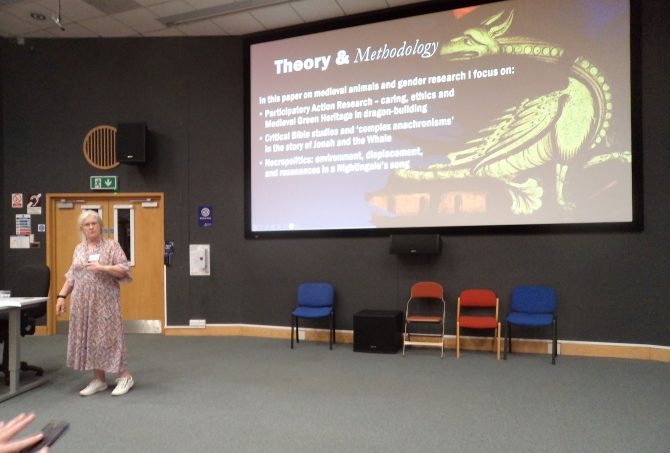
The panel on ‘Carelessness?’ (Panel 7) began with a paper by Caitlin Coxon, a PhD student at Cardiff University. Caitlin explored how and why John Gower retold, in his Confessio Amantis, the myth of the rape of Philomela as a crime of theft, thereby underlying its seriousness and that such victims had very little recourse within 14th-century law. Next, Dr Hope Doherty-Harrison shared her new reading of the bedroom scenes in ‘Sir Gawain and the Green Knight’ which she sees enacted by Gawain and Lady Bertilak as they seek to protect one another by both preserving and communicating secrets. Turning to Old English literature, the final paper was given by Lloyd Forster, a PhD student at the University of Dundee, who discussed the poem ‘Wulf and Eadwacer’, foregrounding ‘caregiving as a gendered dynamic central to the poem’s critique of power and emotional relationships.’
As before, these panels were well received, sparking discussion both after the papers and in the break that followed. For the final two sessions, the conference moved to a different format, the first being a fascinating and thought-provoking workshop led by Dr Daisy Black on ‘Feminist Storytelling for Medievalists’. Daisy is a brilliant storyteller, as she demonstrated, and this was accompanied by her interactive engagement with the delegates to explore how medieval stories can be deconstructed/modified/used to provoke reflection and discussion by modern audiences on a broad range of often challenging themes.
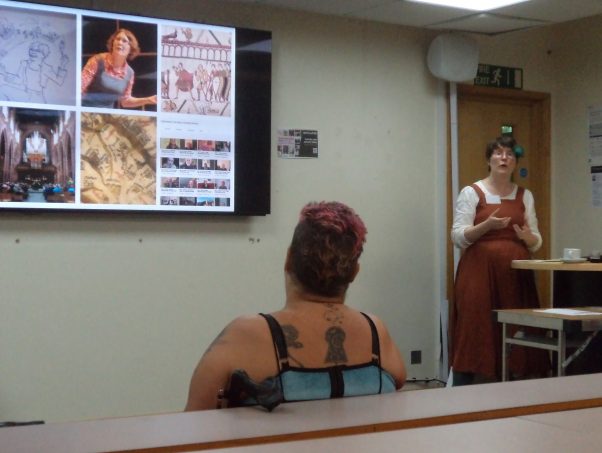
To finish the conference proceedings for the day, there was a wine reception and book launch, including Eva Locher and Brill Books, and Diane Heath and UWP Books. The main part of the launch focused on the new GMS volume edited by Drs Jane Bonsall and Hannah Piercy, which is available through Brepols and is entitled Reconsidering Consent and Coercion: Power, Vulnerability, and Sexual Violence in Medieval Literature.
Friday began with the 2nd plenary lecture, the ECR Lecture given by Dr Kirsty Bolton where Kirsty examined several medieval romances about the interventions of minor, albeit critical characters, who through their care and charity ensured the survival and ultimate wellbeing of certain young women who had been cast adrift in rudderless boats and had ended up in ‘strange lands’. As well as providing degrees of continuity (and contrast) between medieval and modern lives, her presentation resonated with others during the conference and especially that of Vicki Blud (see above).
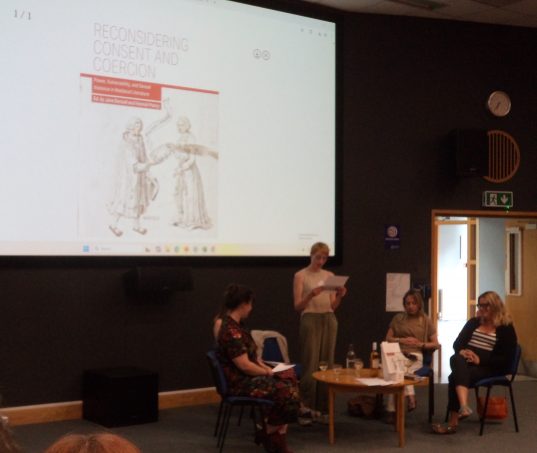
The late morning session offered a choice of ‘Maternity and Mothering’ (Panel 8) and ‘Saintly Places and Spaces’ (Panel 9). For Panel 8, the first speaker was Chandini Jaswal at the Panjab University, India, who provided a fascinating assessment of the role of wet nurses who nursed royal infants in Mughal India. Using her research, she is challenging colonial narratives about the limited agency of such women and instead sees these Anaghas ‘as indispensable figures in Mughal politics, courtly life and the imperial harem.’ She was followed by Dr Fiona Harris-Stoetz who looked at the evidence surrounding miscarriage in the High Middle Ages, from medical and legal texts to the belts of saints and precious stones, and how, for medieval society, the woman’s virtue was of paramount importance to ensure success. The third paper was given by Dr Akiko Itahashi who provided an assessment of the wives of many civil officials in the Tang period. In particular, she explored their relationships with the children of their husbands’ concubines and how these mother-child relationships were viewed as central to continuing the patrilineal bloodline. Jillian Reid gave the final presentation in this panel where she drew on evidence from material culture to discuss how medieval women ‘exercised emotional agency through these objects.’
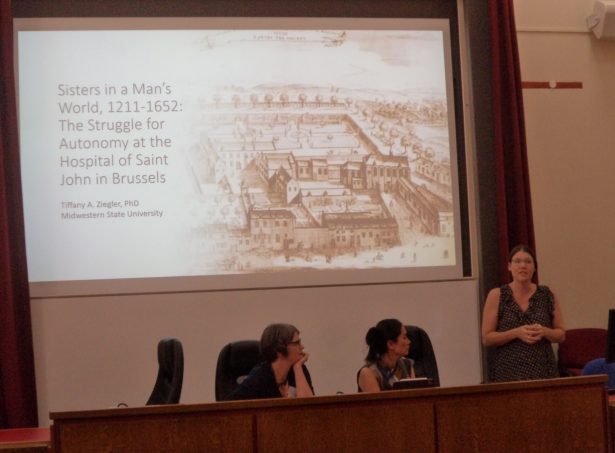
In ‘Saintly Places’, Mikkaela Bailey, a PhD student at The Catholic University of America in Washington, took her audience to East Dereham, Norfolk, and the local cult of St Withburga. This 8th-century abbess was particularly remembered and commemorated for the care she had provided for the workmen who constructed her abbey through the intervention of the Virgin Mary. Moving next to Brussels, Dr Tiffany Zeigler illustrated how the sisters at St John’s hospital there were at times over the medieval and early modern periods able to navigate their relationships with different outside authorities, demonstrating that agency was not solely male and that the sisters negotiated successfully varying and competing roles. Keeping with medieval hospitals, Xiaoli Pan, a PhD student at Rutgers University, discussed the cartularies of 4 hotels-dieu in France in relation to medieval ideas about charity and compassion, with special reference to those suffering from visible forms of disability. The final speaker, Professor Julie Paulson, stayed with the notion of disability and turned her attention to how she sees such ideas in Julian of Norwich’s Revelations. She considers Julian ‘refuses to treat bodily and mental weakness as aberrations to be overcome; instead, they become sites of divine compassion and epistemological insight.’
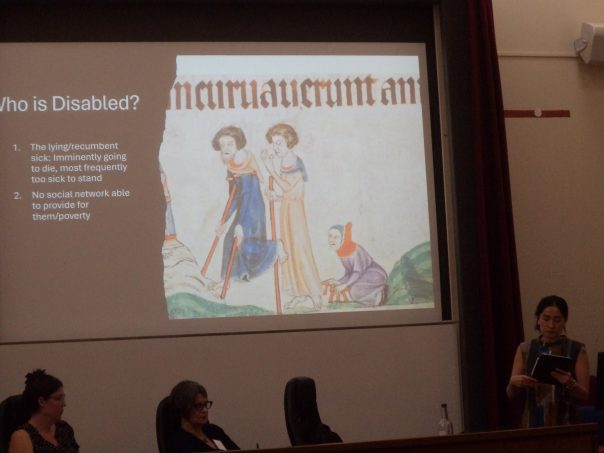
Such panels were well received and provoked a range of comments and questions, thereby bringing the conference to the lunch break and the GMS business meeting. The next session comprised a round table on the topic of ‘Unruly Wombs’ before delegates moved to the final two panels of ‘Charitable Networks’ (Panel 10) and ‘Caring Spirituality’ (Panel 11). For the former, the first presentation was given by Dr Mary Anne Gonzales who explored what she called ‘artificial’ gendered boundaries in the care given to men’s bodies at the 18 beguine hospitals in 13th-century Douai. Keeping with ideas about caring communities and the potential for interactions between women and men, Dr Elizabeth Kinne investigated usual and unusual ideas found in a 15th-century Middle Scots advice text for young women. Focusing especially on the latter, she sees this as highlighting the need for medieval communities to see that the virtue of young women as a collective responsibility as a means to ensure they do not ‘fall’ due to problematic economic circumstances. Dr Hannah Piercy’s caring communities, as seen in Middle English romance, featured ‘how care relationships bring [male] characters together across the medieval globe and counter the more antagonistic and violent relationships that emerge elsewhere.’ Furthermore, in her presentation, that also drew on her collaborative work with Dr Emily Dolmans, she addressed questions about these portrayals of care and masculinity with reference to matters relating to patronage and sponsorship.
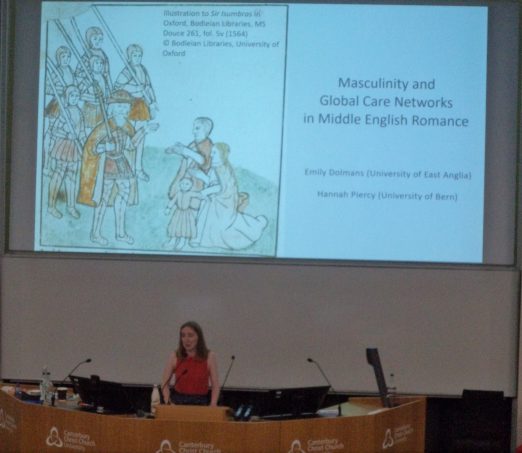
Moving to the ‘Caring Spirituality’ (Panel 11), Dr James White used the specific incident in Catherine of Siena’s Life concerning her commitment to caritas through her treatment of a woman with breast cancer to highlight how her actions and the divine vision she thereafter experienced were part of the developing doctrine of concomitance. The next presentation by Caitlin Kane, a PhD student at UCL, explored certain aspects of the Lives of Clare and Francis of Assisi to highlight matters relating to the blurring of gender distinctions and thereby ‘fostering a queer spiritual community in Christ.’ Dr Mary Beth Long gave the penultimate presentation where she examined the English Lives of St Marina to discuss the centrality of children and childcare in these narratives, as well as those who provide such care. The final speaker was Dr Alicia Smith who examined the ‘legendary saintly figure of Thais, sex worker turned saint, and the monk, Paphnutius who converts and encloses her as a recluse’ to ask how it might have been seen to relate by contemporaries to the real world beyond the page. Both panels gave rise to interesting discussions before the final break and a discursive session led by Dr Rachel Moss who posed the question ‘What does a truly feminist conference look like when the world is on fire?’ This provoked a broad range of ideas and suggestions, and it will be fascinating to see how some at least can be implemented at future GMS conferences.
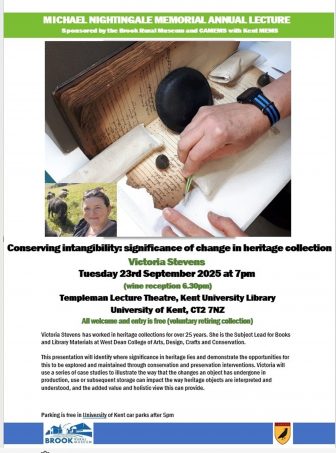
At this point, it was time to draw proceedings to a close and as well as thanking Diane for organising a fantastic conference, Diane herself thanked the GMS steering committee and all those who had made it such a successful event, including all those who had chaired panels and who had helped in so many ways. Consequently, I shall add here our many thanks to CCCU Hospitality under Louise Mallon who went beyond all expectations. Also, many thanks are due to Joe Cherry, Operations Support Officer, who has given Diane and me a great deal of assistance with the logistical arrangements, and similarly we are very grateful to Toby Charlton-Taylor for AV support. This meant we not only had an international conference at Canterbury, but through Teams could extend it online to speakers from as far away as Canada and India – Toby, much appreciated as always! Although not part of the conference, a number of delegates stayed on to see the Medieval Pageant yesterday, as well as to visit a large number of sites across the city as part of the Family Heritage Trail. As the primary sponsor, CCCU had three ‘heritage’ sites on its campus, but, as always, the CKHH was based in the city itself. This year Dr Claire Bartram, Christine Brandl, a PhD student, and I were at St Mildred’s church, and we are very grateful for the assistance of Claire’s son and his friends, the Revd Jo Richards, Tessa Taylor and several members of the St Mildred’s congregation.
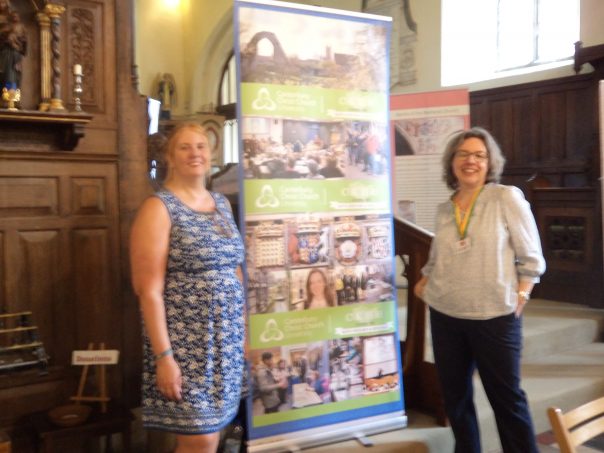
At certain times during the day, we had a steady stream of visitors – young and old – who enjoyed the family-friendly design work on offer in terms of producing a scallop shell design for a pilgrim badge. Moreover, we benefitted from the choir in the early afternoon, I think we met them at St Paul’s church during the Medieval Pageant in 2024.
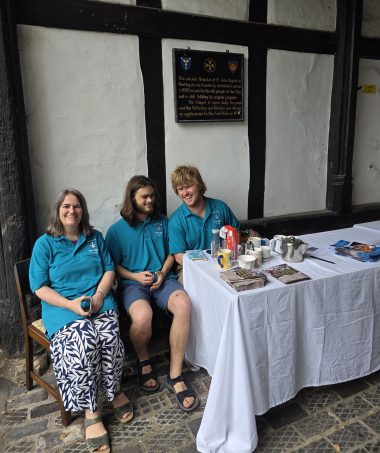
On the other side of the city, Michelle Crowther (and family) with Diane Heath were based at St John’s hospital. This is the first year St John’s has taken part in the Family Trail and hopefully it will feature in future years. Because of the growing number of places now involved, I’m not sure Peter Joyce (another doctoral student), as an official photographer, was able to include St John’s, but we certainly saw him at St Mildred’s which was great.
So that’s it and apologies for the length but I wanted it to be as inclusive as possible because the Kent History Postgraduates group, like the CKHH, have been fantastic communities of scholars who have understood the value of mutual support both within the institution and across constituencies, whether we are talking about the city of Canterbury or the county of Kent, or even further afield. Nevertheless, as the saying has it ‘as one door closes another opens’, and hopefully I shall be opening that new door before too long as I and most of my postgraduate students find ourselves needing another ‘home’.
 Centre for Kent History and Heritage
Centre for Kent History and Heritage Sheila Sweetinburgh
Sheila Sweetinburgh 4409
4409


We shall miss you so much, Sheila. Thank you for everything single one of your 530 blogs. This is a very sad day for all your readers
Thanks Diane, and three interesting birds to end on.
I totally agree with Diane.
Thanks very much Mary, you have been a great supporter of of this for years.
Thank you Sheila. I have appreciated them & have been reading them despite my presence at only a few.
Nalini
Many thanks Nalini, glad these have been of interest over the years
Congratulations on 530 fabulous blogs. We will really miss these! Thank you for all of them and the huge amount of work that went into producing them.
Many thanks Imogen, and who knows what the future will bring ….
What a beautiful farewell to CKHH. Thank you Sheila for the stories, the heart and the history. I wish you and the team all the best in your next chapter.
Many thanks, delighted to hear that you enjoyed the blog and hopefully a new chapter will start shortly.